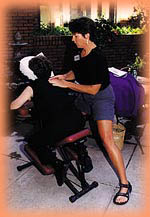|
|
|
|
The definitions that follow provide
a brief explanation of only a few of the techniques currently in
practice. These definitions have been compiled from a wide variety
of sources. While some were supplied by the developer of the technique,
others were supplied by associations and educational institutions
involved with the individual technique.
 Seated Massage Techniques which provide fully-clothed seated massage, bodywork and somatic therapies to clients, generally in a corporate or business setting. Practitioners utilize Shiatsu, Amma, and/or Swedish techniques. Neuromuscular
Therapy
This comprehensive program of soft-tissue manipulation balances the body's central nervous system with the musculoskeletal system. Based on neurological laws which explain how the central nervous system initiates and maintains pain, the goal is to help relieve the pain and dysfunction by understanding and alleviating the underlying cause. Neuromuscular therapy can help individuals who experience distortion and biomechanical dysfunction, which is often a symptom of a deeper problem. It is also used to locate and release spasms and hypercontraction in the tissue, eliminate trigger points that cause referred pain, restore postural alignment, proper biomechanics and flexibility to the tissues, rebuild the strength of injured tissues, and assist venous and lymphiatic flow.
Alexander
Technique
The Alexander Technique is movement education in which the student is taught to sit, stand and move in ways that reduce physical stress on the body. Alexander Technique teachers use gentle manual guidance and verbal cues to improve a students' posture and movement patterns. A lesson or group class typically involves basic movements such as sitting, standing, walking, bending, reaching, carrying and lying down. It may also involve more specialized activities such as playing a musical instrument, working at a computer etc. The teacher's manual guidance stresses the adjustment of the head, neck and torso relationship. In the beginning lessons, the teacher closely monitors the student. Later, the student learns to monitor him or herself, ultimately learning a unique self-management process - an understanding of balance and dynamic postural control. More information about the Alexander Technique can be found at The Complete Guide to the Alexander Technique web site at www.alexandertechnique.com.
home | therapies explained | what to expect | benefits of massage |